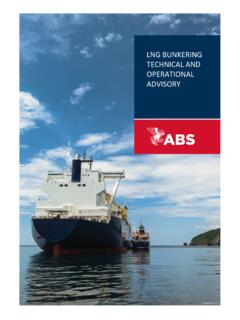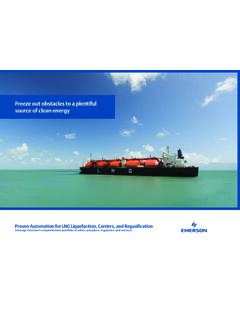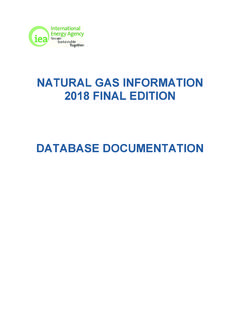Transcription of Liquefied Natural Gas - Energy
1 Understanding the Basic FactsLiquef ied Natural Gas:About This ReportGrowing Demand for Natural GasNatural gas plays a vital role inthe Energy supply and inachieving the nation s economicand environmental Natural gas productionin North America is projected to gradually increase through2025, consumption has begunto outpace available domesticnatural gas supply. Over time,this gap will of the Global LNG MarketOne of several proposedsupply options would involveincreasing imports of liquefiednatural gas (LNG) to ensurethat American consumers haveadequate supplies of naturalgas in the enables naturalgas that would otherwise be stranded to reach majormarkets.
2 Developing countrieswith plentiful Natural gasresources are particularlyinterested in monetizingnatural gas by exporting it asLNG. Conversely, moredeveloped nations with little or no domestic Natural gas rely on imports. I strongly support developingnew LNG capacity in the United States. President George W. BushUnderstanding the Liquef ied Natural Gas:This report was prepared by the of Energy (DOE) incollaboration with the NationalAssociation of Regulatory UtilityCommissioners (NARUC). DOE s Office ofFossil Energy supports technologyresearch and policy options to ensureclean, reliable, and affordable suppliesof oil and Natural gas for Americanconsumers, working closely with theNational Energy Technology Laboratory,which is the Department s lead centerfor the research and development ofadvanced fossil Energy , a nonprofit organizationcomposed of governmental agenciesengaged in the regulation oftelecommunications, Energy , and waterutilities and carriers in the 50 states, theDistrict of Columbia, Puerto Rico.
3 Andthe Virgin Islands, serves the publicinterest by improving the quality andeffectiveness of utility and editorial support: AkoyaSelect photos courtesy of: Anadarko PetroleumCompany; Atlantic LNG Company of Trinidad andTobago; British Petroleum; Chevron Texaco;ConocoPhillips; Dominion Cove Point LNG, LP;Excelerate Energy ; HOEGH LNG; Pine Needle LNG, LLCNC; Texaco Production Operations; Tractebel LNGN orth America; Trunkline LNGPageCurrent Status of LNG ImportsThe United States currently has six LNG terminals four on the mainland, one in theoffshore Gulf of Mexico, andone in Puerto Rico thatreceive, store, and regasify economists call for thedevelopment of more importcapacity to enable the UnitedStates to participate fully inworld LNG LNG imports wouldlikely help to dampen naturalgas price volatility in the UnitedStates, particularly during peakperiods of demand.
4 Suchexpanded imports would alsosupport economic of the LNG Value ChainIf the United States is toincrease LNG imports,significant capital investmentwill be necessary by energyfirms across the entire LNG value chain, which spansnatural gas production,liquefaction capacity, transportshipping, storage, andregasification. Over the past two decades,technology improvements have been key to a substantialincrease in liquefactionefficiency and decrease in LNG Decision MakingFor more than 40 years, thesafety record of the global LNGindustry has been excellent, due to attention to detail inengineering, construction, and operations.
5 More than 30 companies have recentlyproposed new LNG terminalsin North America, along coastline or offshore. Eachproposal is rigorously evaluatedbefore an LNG terminal can beconstructed or expanded. Americans face the challengeof making sound and timelydecisions about LNGinfrastructure to assure anabundant supply of Natural gasfor homes, businesses, industry,and power generators, in thenear and long term. Basic Facts6816 Growing Demand forNatural GasFIGURE 1 Natural gas accounted for almost one-quarter of all Energy used in the United States from United States relies on clean-burning Natural gasfor almost one quarter of all Energy used.
6 Natural gashas proven to be a reliable and efficient Energy sourcethat burns much cleaner than other fossil fuels. In thelast 10 years, the United States produced between 85and 90 percent of the Natural gas it the balance was imported by pipeline from Canada. Annual Natural gas consumption is projected to rise from trillion cubic feet (Tcf) in 2004 Tcf in for the increase include: Utilities realize advantages by using Natural gas-fired generators to create electricity (lower capitalcosts, higher fuel efficiency, shorter constructionlead times, and lower emissions).
7 The residential sector benefits from the higher fuelefficiency and lower emissions of gas appliances. The industrial sector relies on Natural gas as afeedstock or fuel for manufacturing many of theproducts we rely on today, including pulp andpaper, metals (for computers, automobiles, andtelecommunications), chemicals, fertilizers, fabrics,pharmaceuticals, and plastics. The transportation sector is beginning to seenatural gas as a clean and readily availablealternative to other fossil demand is rising, production of Natural gasin major mature provinces, including North America, isbeginning to decline.
8 Lack of a steady supply increasesthe potential for higher Energy prices and price volatility,which affect the profitability and productivity of industryand may spur certain gas-intensive industries to relocateto parts of the world where Natural gas is less , in turn, could impact jobs, Energy bills, and theprices paid for consumer way to help meet rising demand would be toincrease imports of Natural gas from outside NorthAmerica. Net imports of Natural gas are projected tosupply 19 percent of total consumption in 2010( Tcf) and 28 percent in 2025 ( Tcf).
9 3 Thisnatural gas will be transported via ship in the form ofliquefied Natural gas (LNG). Net imports of LNG areexpected to increase from Tcf in 20044to morethan 6 Tcf in 2025 at that point satisfying almost 21 percent of total Natural gas of the benefits and risks of expanding LNGimports will be central to Energy supply decisionsin the years ahead. A key consideration is the potentialof LNG imports to ensure that adequate and reliablesupplies of Natural gas are available to support growth. Numerous recent studies have underscored theimportance of LNG in the nation s Energy future: A 2003 study by the National Petroleum Councilconducted at the request of the Secretary of Energyfound several keys to ensuring a reliable, reasonablypriced Natural gas supply to meet future including increased imports of A 2004 Energy Information Administration (EIA)study, Analysis of Restricted Natural Gas SupplyCases, included a forecast scenario based on a restricted expansion of LNG importterminals.
10 The results showed an increase in Natural gas prices, dampening consumption andeconomic growth. A 2004 study by the Manufacturers Allianceoutlined the critical role of Natural gas inmanufacturing and the potential contribution ofLNG to improve industrial competitiveness in the global : Energy Information Administration, Annual Energy Outlook SAFE FUEL IN A SMALL PACKAGEN atural gas consists almost entirely of methane (CH4), the simplest hydrocarboncompound. Typically, LNG is 85 to 95-plus percent methane, along with a fewpercent ethane, even less propane and butane, and trace amounts of nitrogen(Figure 2).


















